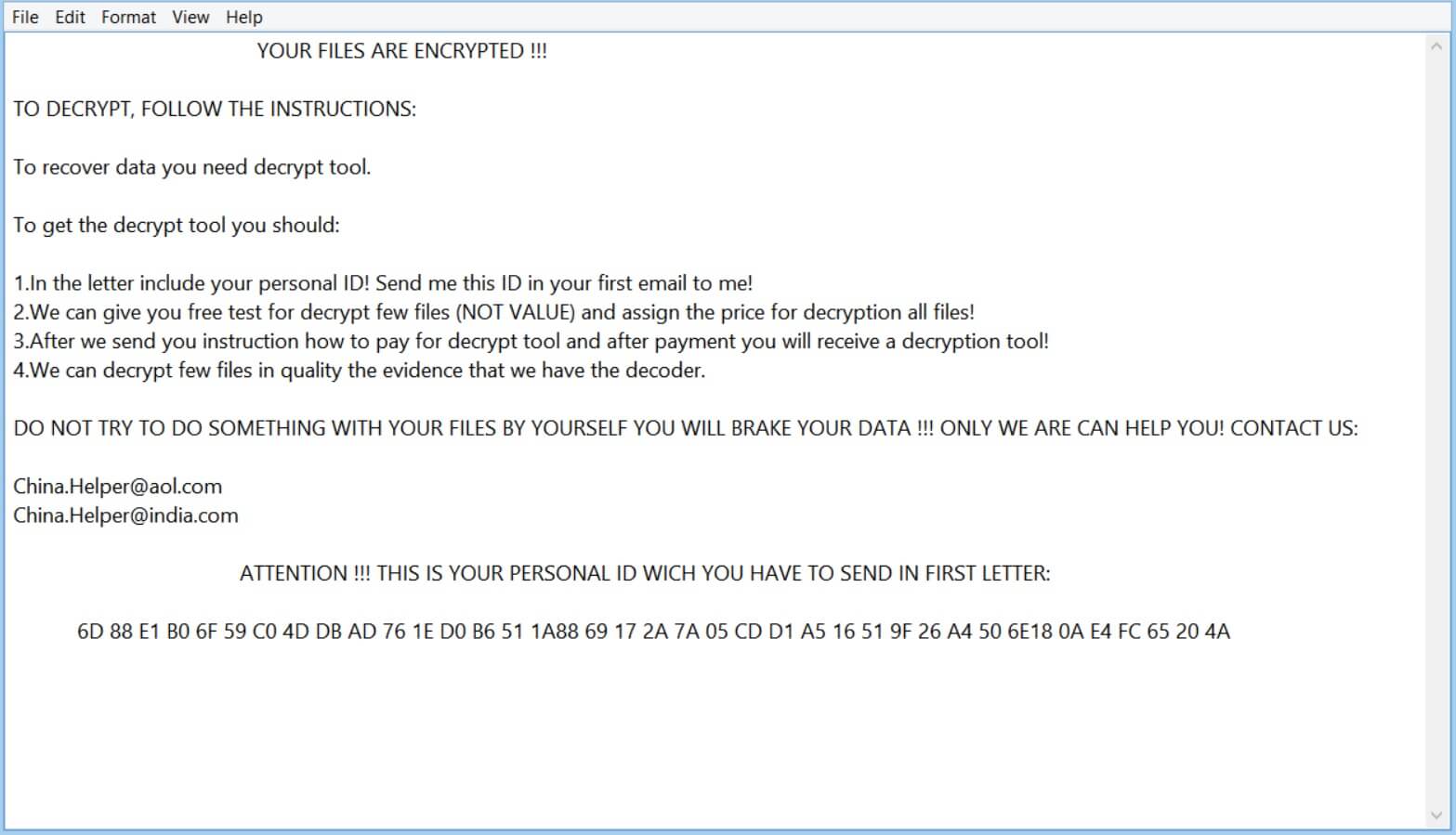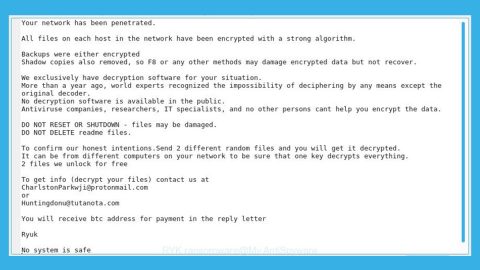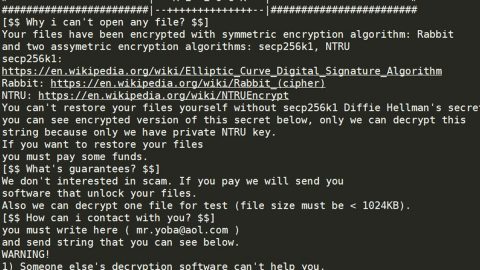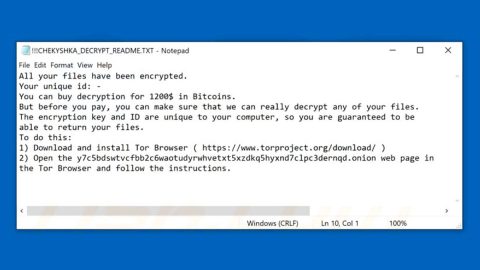What is Rabit4444 ransomware? And how does it carry out its attack?
Rabit4444 ransomware is a data-encrypting malware designed to lock important data in a targeted PC. It is yet another variant of the notorious GlobeImposter ransomware and this time, it uses a “.rabit4444” extension in marking the files it encrypts. Aside from the extension used, there is no other notable change in this new malware strain.

The instant it carries out its attack, Rabit4444 ransomware will drop its malicious payload in the system which is the one that initiates a connection to a remote server controlled by the attackers. It then executes several modules and encrypts stored data in the computer using a sophisticated encryption algorithm. And during the encryption process, the malware appends each file with the “.rabit4444” extension. After the files are encrypted, Rabit4444 ransomware creates a text file named HOW_TO_BACK_FILES.txt and places it on the desktop. The text file contains its ransom note with the following message:
“YOUR FILES ARE ENCRYPTED !!!
TO DECRYPT, FOLLOW THE INSTRUCTIONS:
To recover data you need a decrypt tool.
To get the decrypt tool you should:
1. In the letter include your personal ID! Send me this ID in your first email to me!
2. We can give you a free test for decrypting a few files (NOT VALUE) and assign the price for decryption of all files!
3. After we send you instructions on how to pay for the decrypt tool and after payment, you will receive a decryption tool!
4. We can decrypt few files in quality the evidence that we have the decoder.
DO NOT TRY TO DO SOMETHING WITH YOUR FILES BY YOURSELF YOU WILL BREAK YOUR DATA !!! ONLY WE ARE CAN HELP YOU! CONTACT US:
[email protected]
[email protected]
ATTENTION !!! THIS IS YOUR PERSONAL ID WHICH YOU HAVE TO SEND IN YOUR FIRST LETTER:
6D 88 E1 B0 6F 59 C0 4D DB AD 76 1E D0 B6 51 1A88 69 17 2A 7A 05 CD D1 A5 16 51 9F 26 A4 50 6E18 0A E4 FC 65 20 4A”
In its ransom note, cyber crooks urge users to send an email with their personal ID to initiate contact. They tempt victims into paying by claiming to decrypt a few encrypted files at no cost. However, under any circumstances, you must not give in to these crooks’ demands as you could end up losing a huge sum of money for nothing. The best way to deal with these kinds of threats is to terminate the ransomware from your computer as soon as you notice its existence in your computer and then try alternative ways to restore the affected files.
How does Rabit4444 ransomware spread over the web?
Rabit4444 ransomware, just like other GlobeImposter variants, spread the web using several distribution techniques and one of the most commonly used methods is malicious spam email campaigns. Cybercriminals tend to attach an obfuscated attachment to emails and disguise them to trick users into downloading and opening the infected attachment. Thus, you need to be more cautious in opening emails and downloading attachments as it could be a malicious payload of dangerous threats like Rabit4444 ransomware.
Make sure to follow the removal instructions laid out below to obliterate Rabit4444 ransomware from your computer effectively.
Step_1: First, you have to stop the malicious process of Rabit4444 ransomware by opening the Task Manager. To do that, simply tap Ctrl + Shift + Esc keys on your keyboard.
Step_2: Under the Task Manager, switch to the Processes tab and find a process named svhost.exe as well as any suspicious-looking process that takes up most of your CPU’s resources and is most likely related to Rabit4444 ransomware.
Step_3: After that, close the Task Manager.
Step_4: Tap Win + R, type in appwiz.cpl and click OK or tap Enter to open Programs and Features under Control Panel.
Step_5: Under the list of installed programs, look for Rabit4444 ransomware or anything similar, and then uninstall it.
Step_6: Next, close the Control Panel and tap Win + E keys to launch File Explorer.
Step_7: Navigate to the following locations below and look for Rabit4444 ransomware’s malicious components such as HOW_TO_BACK_FILES.txt, and [random].exe, as well as other suspicious files, then delete all of them.
- %TEMP%
- %WINDIR%\System32\Tasks
- %APPDATA%\Microsoft\Windows\Templates\
- %USERPROFILE%\Downloads
- %USERPROFILE%\Desktop
Step_8: Close the File Explorer.
Before you proceed to the next steps below, make sure that you are tech-savvy enough to the point where you know exactly how to use and navigate your computer’s Registry. Keep in mind that any changes you make will highly impact your computer. To save you trouble and time, you can just use Restoro, this system tool is proven to be safe and excellent enough that hackers won’t be able to hack into it. But if you can manage Windows Registry well, then by all means go on to the next steps.
Step_9: Tap Win + R to open Run and then type in Regedit in the field and tap enter to pull up Windows Registry.
Step_10: Navigate to the following path and then delete any suspicious registry keys and sub-keys created by Rabit4444 ransomware:
- HKEY_CURRENT_USER\Control Panel\Desktop\
- HKEY_USERS\.DEFAULT\Control Panel\Desktop\
- HKEY_LOCAL_MACHINE\Software\Microsoft\Windows\CurrentVersion\Run
- HKEY_CURRENT_USER\Software\Microsoft\Windows\CurrentVersion\Run
- HKEY_LOCAL_MACHINE\Software\Microsoft\Windows\CurrentVersion\RunOnce
- HKEY_CURRENT_USER\Software\Microsoft\Windows\CurrentVersion\RunOnce
Step_11: Once done, exit the Registry Editor and flush the DNS cache. To do that, just, right-click on the Start button and click on Command Prompt (administrator). From there, type the “ipconfig /flushdns” command and hit Enter to flush the DNS.
Step_12: Close the Registry Editor and empty the Recycle Bin.
Try to recover your encrypted files using the Shadow Volume copies
Restoring your encrypted files using Windows Previous Versions feature will only be effective if Rabit4444 ransomware hasn’t deleted the shadow copies of your files. But still, this is one of the best and free methods there is, so it’s definitely worth a shot.
To restore the encrypted file, right-click on it and select Properties, a new window will pop up, then proceed to Previous Versions. It will load the file’s previous version before it was modified. After it loads, select any of the previous versions displayed on the list like the one in the illustration below. And then click the Restore button.
Congratulations, you have just removed Rabit4444 Ransomware in Windows 10 all by yourself. If you would like to read more helpful articles and tips about various software and hardware visit fixmypcfree.com daily.
Now that’s how you remove Rabit4444 Ransomware in Windows 10 on a computer. On the other hand, if your computer is going through some system-related issues that have to get fixed, there is a one-click solution known as Restoro you could check out to resolve them.
This program is a useful tool that could repair corrupted registries and optimize your PC’s overall performance. Aside from that, it also cleans out your computer for any junk or corrupted files that help you eliminate any unwanted files from your system. This is basically a solution that’s within your grasp with just a click. It’s easy to use as it is user-friendly. For a complete set of instructions in downloading and using it, refer to the steps below
Perform a full system scan using Restoro. To do so, follow the instructions below.













